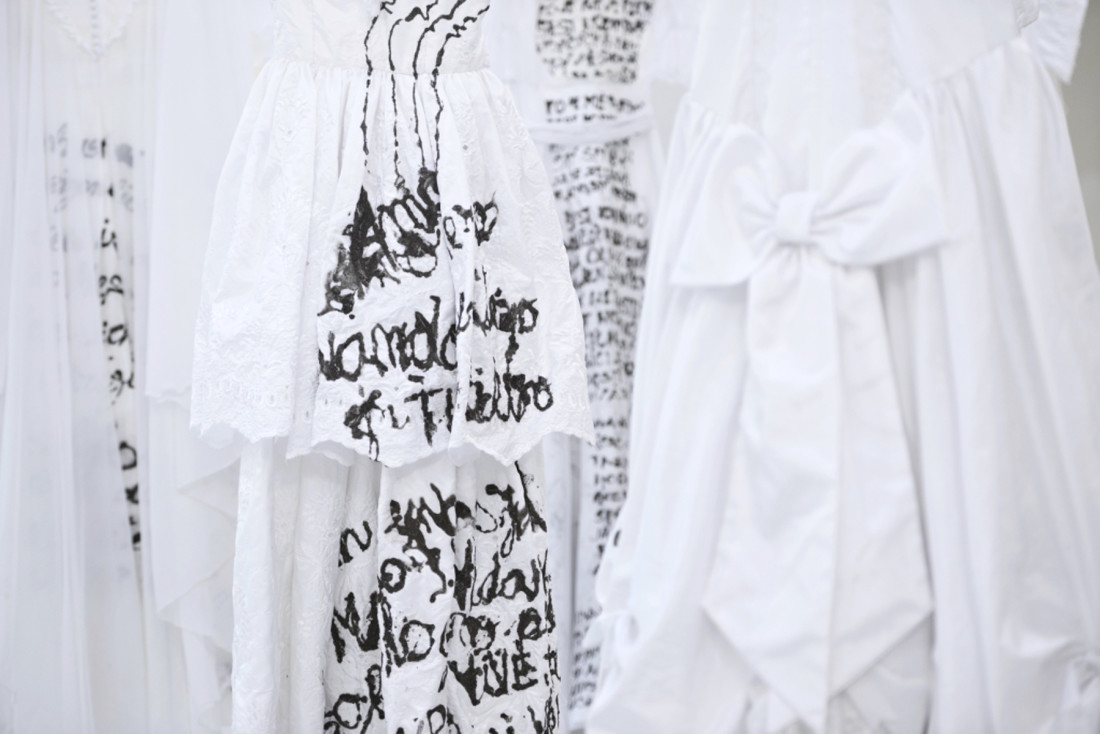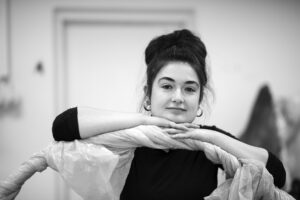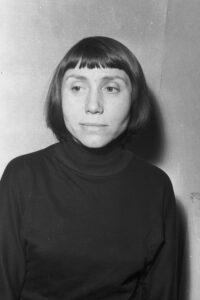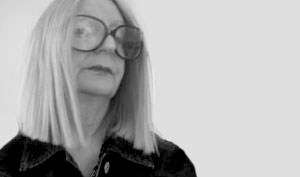Margita Titlová Ylovsky
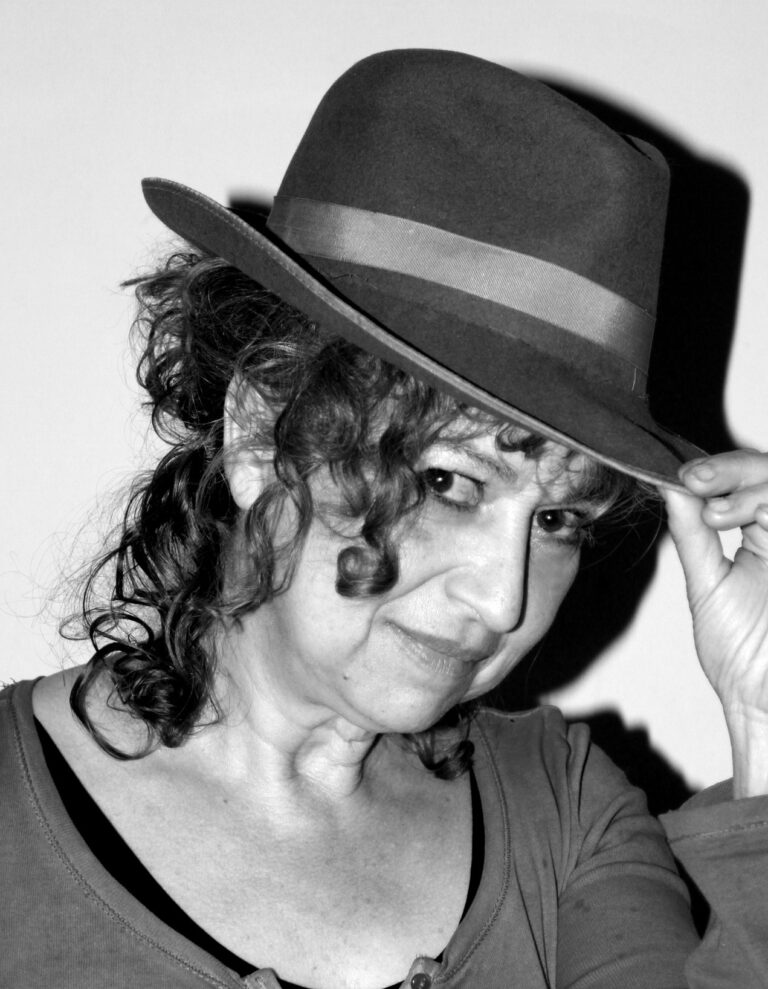
– born in 1957 in Prague. She joined the Academy of Fine Arts in Prague in 1977. Between 1998 and 2011, she was the head of the Graphics and Visual Communication Studio at the Faculty of Fine Arts at the Brno University of Technology. In 2012 and 2013 she was leading the Painting Studio at the Institute of Art and Design at the University of West Bohemia in Pilsen. Since 2013, she has been lecturing at the Jan Evangelista Purkyně University in Ústí nad Labem. Margita Titlová-Ylovsky often combines various artistic approaches and disciplines, mainly painting and drawing, installation and sculpture. Her works are driven by archetypal ideas about the world and human existence, some works are inspired by physics of mathematics (e.g. chaos theory, quantum mechanics, etc.). The artist’s basic expressive medium is to capture immediate gesture and reactions of immediate emotional state.
Mapping of spiritual space
The influence of the political situation on social relations and art
In the 1970s and 1980s, political surveillance was most pronounced in the supervision of artists and the arts. This repressive state induced the separation of art from normal everyday life. It became an independent underground world that facilitated a certain awareness of the work of practising artists. These political conditions made it impossible for artists to exhibit their work and make a living through their artistic practices. Art was an essential part of the preservation of spiritual freedom and became a certain moral attitude and an expression of courage. Czechoslovakia was divided from the rest of the world, without information nor the possibility to travel. In such an environment, the artists used to come together and discuss their opinions amongst themselves. The women artists did not need to separate themselves from this community through feminism. At that time, “women’s art” was associated with more decorative forms of art that would be dealing with floral motifs, and would gravitate towards kitsch. Galleries and museums were empty and bored, and people were no longer used to visiting exhibitions and seeking out art. At the time, there was no feminist art, only good and bad art. Artists worked out of the need for their own self-realisation and as a form of preservation of their dignity. The art they created often ended up locked in a drawer — they were creating for themselves at home. Perhaps a few close friends would see the work or it would get shown at one of the unofficial underground exhibitions… Many excellent works of art were created at the time, including works created by women.
Artists the lone runners
Exhibitions in alternative spaces, studio-apartments.
The period before 1989 and some years after have not yet been objectively researched and processed in its entirety, especially the importance of women artists in relation to the position of women in society and the political influence on thinking and artistic expression.
Projects and topics, reactions to the social life of Margita Titlová Ylovsky
Intimacy
Self-portraits of photography — man in relation to his existence — touching the shadow1.
Dimensions of the seen, drawings and reality.
To see oneself — Measuring — a comparison of oneself with nature, the movement of the wind and the body, against a rock, with a stone and a line. Relationships of the body and geometry in nature. What Remains After Human Existence — actions in space with man and actions without human existence, expressive installations, installations with lines and the human body2.
Monumentalisation of drawings and paintings
Touching a shadow, touch as a manifestation of the first artistic deed. Drawings in the shadow, abstract drawings3.
Kirlian’s device — drawing with human energy, scanned on photo paper4.
Image
Public space and human individuality.
Glamour girls — film and newspapers, the influence of popular media on the aesthetics of women5, Rococo now6, billboards in public spaces, wigs, Body Objects7, artificial flowers.
A chemical garden
Sculptures and objects, geometry and energy of magnets, gravity and thermal buoyancy, a flight in a blue balloon8.
Body energy
Images based on thermal imaging9.
Videos documenting drawings, paintings, created by human heat and energy.
Light and darkness
Installation in space and a beam of light, creating colour through a crystal. Light transforming into colour in the image. A beam of light and its transformation into a colour spectrum in an object.
Drawings created in the dark.
Sit in the field
Using clay and dirt instead of paint in paintings, objects, wedding dresses10.
Projects since 2015
Invisible energies and transformations of matter in visual arts.
The text was created in collaboration with Marianna Placáková (2021).
1Image: Margita Titlová Ylovsky, I am standing in front, performance, the 1980s. Courtesy of the artist.2Image: Margita Titlová Ylovsky, Landscape, performance, the 1980s. Courtesy of the artist.
3Image: Margita Titlová Ylovsky, Drawing with a lipstick, the 1980s. Courtesy of the artist.
4Image: Margita Titlová Ylovsky, Drawing with Kirlian's device, 1982. Courtesy of the artist.
5Image: Margita Titlová Ylovsky, Wigs, 1992. Courtesy of the artist.
6Image: Margita Titlová Ylovsky, Elissa Lin Meyer, Rocovo Now, Praha: ÚLUV 1992. Courtesy of the artist.
7Image: Margita Titlová Ylovsky, Body Objects, 1992. Courtesy of the artist.
8Image: Margita Titlová Ylovsky, A Chemical Garden, Sokolov, 2011. Courtesy of the artist.
9Image: Thermovision, 2007.
10Image: Margita Titlová Ylovsky, Love Letters, 2015. Courtesy of the artist.
-– narozena roku 1957 v Praze, v roce 1977 nastoupila na AVU v Praze, mezi léty 1998 až 2011 byla vedoucí ateliéru Grafika a vizuální komunikace na Fakultě výtvarného umění Vysokého učení technického v Brně, v letech 2012 a 2013 vedoucí Ateliéru malby v Ústavu umění a designu Západočeské univerzity v Plzni, od roku 2013 přednáší na Univerzitě Jana Evangelisty Purkyně v Ústí nad Labem. Margita Titlová-Ylovsky často kombinuje různé umělecké přístupy a disciplíny, především malbu a kresbu, instalaci a sochařství. Její práce jsou poháněny archetypálními myšlenkami o světě a lidské existenci, některá díla jsou inspirována fyzikou matematiky (např. teorie chaosu, kvantová mechanika atd.). Základním výrazovým médiem umělce je zachycení okamžitých gest a reakcí bezprostředního emocionálního stavu.
Mapování duchovního prostoru
Vliv politické situace na sociální vztahy a umění
V 70. a 80. letech se politický dohled nejvíce projevoval v kontrole umělců a umění.
Tento represivní stav ovlivnil oddělení umění od normálního života. To se stalo samostatným underground světem, ve kterém fungovala jistá informovanost o výtvarné práci umělců. Tento stav znemožňoval umělcům a umělkyním vystavovat a uměním se živit. Umění bylo součástí uchování duchovní svobody a stalo se i jistým morálním postojem a projevem odvahy. Československá republika byla uzavřená od okolního světa, informací i možnosti cestovat. V tomto prostředí se umělci spíše semkli a sdíleli společně své názory. Ženy umělkyně neměly potřebu se z tohoto společenství vyčleňovat ve formě feminismu. Obecně bylo ve společnosti v té době „ženské umění” vnímáno spíše jako dekorativní nebo zabývající se květinovými motivy až kýčovité. Galerie a muzea zely prázdnotou a nudou a lidi si odvykli chodit za uměním. V té době nebylo feministické umění, bylo jen dobré a špatné umění.
Umělci pracovali z potřeby vlastní seberealizace a zachování své důstojnosti. Umění vytvářeli tak zvaně do šuplíku… to znamená pro svou vlastní potřebu nebo pro pár přátel, nebo výstavu, která nebyla oficiální… V té době vzniklo mnoho vynikajících uměleckých děl, včetně děl, které vytvořily ženy.
Umělci osamělí běžci
Výstavy v alternativních prostorech, ateliérech bytech.
Doba před rokem 1989 i po něm není ještě zcela objektivně zpracovaná, zvláště význam umělkyň v závislosti na postavení žen ve společnosti a také politického vlivu na myšlení a umělecký projev.
Projekty a témata, reakce na společenský život Margity Titlové Ylovsky
Intimita
Autoportréty fotografie – člověk ve vztahu ke svému bytí – dotyk se stínem1. Dimenze viděného, kresby a realita.
Vidět sebe – Poměřování – srovnávání se s přírodou, pohyb větru a těla, proti skále, s kamenem a linií. Vztahy těla a geometrie v přírodě. Co zůstává po lidském bytí – akce v prostoru s člověkem a akce bez lidského bytí, expresivní instalace, instalace s liniemi a lidským tělem2.
Monumentalizace kreseb, obrazů
Dotek se stínem, dotek jako projev prvního výtvarného počinu. Kresby do stínu, abstraktní kresby3.
Kirlianův přístroj – kresby lidskou energií snímané na fotopapír4.
Image
Veřejný prostor a lidská individualita.
Glamour girls – film a noviny, vliv populárních médií na estetiku žen,5 Rokoko nyní6, billboardy ve veřejném prostoru, paruky, Objekty na tělo7, umělé květiny.
Chymická zahrada
Sochy a objekty, geometrie a energie magnetů, zemská přitažlivost a nadnášení teplem, let modrým balónem8.
Energie těla
Obrazy vzniklé na základě termovize9.
Videa dokumentující kresby, obrazy, vytvářené lidským teplem a energií.
Světlo a tma
Instalace v prostoru a světelný paprsek, skrze krystal vytváření barvy. Světlo v transformaci do barvy na obraze. Světelný paprsek a jeho transformace v barevné spektrum v objektu.
Kresby vytvářené ve tmě.
Zasaď se do pole
Hlína země použitá místo barvy na obrazech, objektech, svatebních šatech10.
Projekty od r. 2015
Neviditelné energie a transformace hmoty ve vizuálním umění.
Text vznikl ve spolupráci s Mariannou Placákovou (2021).
1Obrázek: Margita Titlová Ylovsky, Stojím před, performance, 80. léta. S laskavým svolením umělkyně.2Obrázek: Margita Titlová Ylovsky, Krajina, performance, 80. léta. S laskavým svolením umělkyně.
3Obrázek: Margita Titlová Ylovsky, Kresby rtěnkou, 80. léta. S laskavým svolením umělkyně.
4Obrázek: Margita Titlová Ylovsky, Kresby Kirlianovým přístrojem, 1982. S laskavým svolením umělkyně.
5Obrázek: Margita Titlová Ylovsky, Paruky, 1992. S laskavým svolením umělkyně.
6Obrázek: Margita Titlová Ylovsky, Elissa Lin Meyers, Margita Titlová Ylovsky: Rokoko nyní, Praha: ÚLUV 1992. S laskavým svolením umělkyně.
7Obrázek: Margita Titlová Ylovsky, Objekty na tělo, 1992. S laskavým svolením umělkyně.
8Obrázek: Margita Titlová Ylovsky, Chymická zahrada, Sokolov, 2011. S laskavým svolením umělkyně.
9Obrázek: Margita Titlová Ylovsky, Termovize, 2007. S laskavým svolením umělkyně.
10Obrázek: Margita Titlová Ylovsky, Milostné dopisy, 2015. S laskavým svolením umělkyně.
